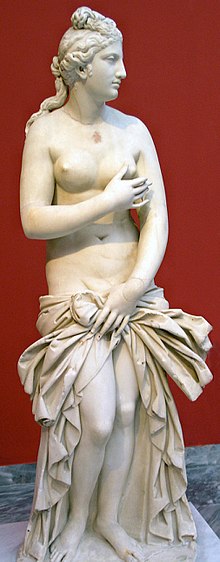Gods and Goddesses
Eastern Mediterranean
Greek
Aphrodite (Foamborn)

ORIGIN: Greek and Cypriot
TYPE: Goddess of Sexual Love
KNOWN PERIOD OF WORSHIP: Identified from circa 1300 BCE (evolving from an earlier prehistoric Asiatic model), until Christianization (circa 400 CE) and later.
SYNONYMS: equating with Istar (Akkadian); Astarte (Syrian); Astoreth (Phoenician); Dione, Cytherea, Venus (Roman)
CENTER(S) OF CULT: Paphos, Amathus and Kition (Cyprus), Corinth and elsewhere on Greek mainland.
ART REFERENCES: Bronze age statuettes (Cyprus); votive stelae; the Parthenon frieze and other contemporary sculpture.
LITERARY SOURCES: Iliad and Odyssey (Homer); Theogony and Hymn to Aphrodite (Hesiod); temple hymns, particularly Hymn of Sappho.
ABODE: Mount Olympus
PLANET: Venus
ANIMALS: Dolphin, Sparrow, Dove, Swan, Hare, Goose, Bee, Fish, Butterfly
SYMBOL: Rose, Seashell, Pearl, Mirror, Girdle, Anemone, Lettuce, Narcissus
TREE: Myrrh, Myrtle, Apple, Pomegranate
DAY: Friday (Hemera Aphrodites)
PARENTS: Zeus and Dione (according to Homer); Uranus (according to Hesiod)
SIBLINGS: The Titans, the Hecatoncheires, the Cyclopes, The Meliae, the Erinyes, The Giants (as daughter of Uranus) or Aecus, Angelos, Apollo, Ares, Artemis, Athena, Dionysus, Eileithya, Enyo, Eris, Ersa, Hebe, Helen of Troy, Hephaestus, Heracles, Hermes, Minos, Pandia, Persephone, Perseus, Rhadamanthus, The Graces, The Horae, The Litae, The Muses, The Morai (as daughter of Zeus)
CONSORT: Hephaestus and others
CHILDREN: Eros, Phobos, Deimos, Harmonia, Pothos, Anteros, Himeros, Hermaphroditus, Rhodos, Eryx, Peitho, The Graces, Priapus, Aeneas
EQUIVALENTS:
- Roman: Venus
- Norse: Freyja
- Etruscan: Turan
- Hinduism: Rati
- Canaanite: Astarte
- Babylonian: Ishtar
- Sumerian: Inanna
- Zoroastrian: Anahita
- Egyptian: Hathor
INFORMATION:
Aphrodite is one of hte major goddesses of the Greek Homeric pantheon, according to legend born as a cosmic deity from the foam of the ocean after her father Ouranos was castrated by Kronos and his genitals were hurled into the sea. In other accounts she is of a "younger" generation, a daughter of Zeus. She is the consort of Hephaistos and occasionally mistress of other deities, including Ares. Through a liaison with the herdsman Anchises she bore Aeneas, who is said to have carried his father to safety on his back during the sack of Troy. Her sacred animal is the goat. Aphrodite seems clearly to have evolved from the Phoenician or Mesopotamian model of a goddess of love and one of her strongest early cults was on the island of Cyprus. Her name derives from the Greek word for the sexual act. She is perceived, in some contexts, as being androgynous and even bearded (see also Artemis). As with her Mesopotamian predecessors she is a goddess of war and victory. Immediate predecessors to the Hellenic model seem to be present in the Mycenaean period particularly at the Kition sanctuary. The Paphos sanctuary definitely suggests Phoenician inspiration. In the Iliad, Aphrodite rescues Paris from his fight with Menelaus and returns him to the arms of Helen in Troy.
In Hellenic art Aphrodite is particularly drawn wearing fine clothes and jewelry. She possesses a girdle with magical properties. The famed statue of the goddess from Cnidos (circa 340 BCE), depicting her naked, is the first of many such erotic interpretations. The temple at Paphos once dispensed model phalli and lumps of salt to cultic pilgrims, and the Corinthian sanctuary enjoyed, according to Strabo, more that a thousand cultic prostitutes.

